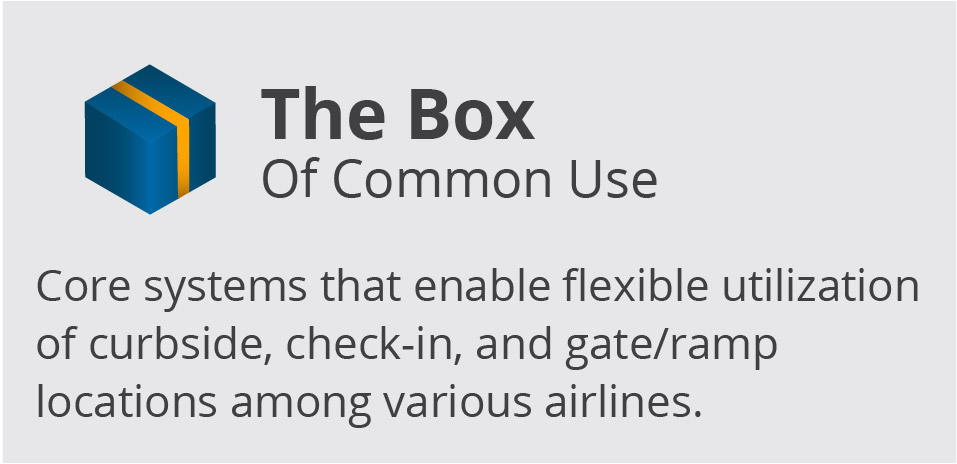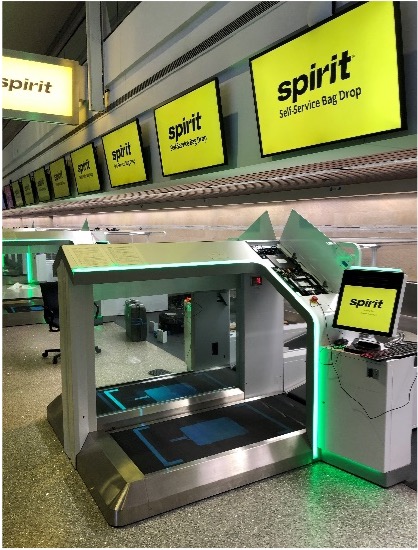
The Box: Background of Common Use at Airports
The Box
From the mid-1980s through the early 2000s, several airports began using systems that enabled the flexible use of check-in, gate, and ramp locations among various airlines. The term “common use” got its start with the International Air Transport Association (IATA), which coined the phrase Common Use Terminal Equipment (CUTE) in their Recommended Practice 1797. When an airport procured a common use system, what they implemented typically consisted of the following items:
- Agent-facing systems with associated peripheral devices, such as boarding pass printers, bag tag printers, card swipes, boarding gate equipment, and bar code reading equipment.
- Customer-facing systems, such as self-service kiosks, with the Common Use Self Service (CUSS) standard confirmed by IATA and rolled out by airports and airlines in the early 2000s.
- Associated dynamic signage systems, which in the early days were not well-integrated and comprised rather tedious manual systems and monitors that may or may not have displayed the precise color used by the airline logos.
This is “The Box” of common use, as summarized in Figure 1.3.1.

Figure 1.3.1: The Box of Common Use
This is what most people think of when they hear “common use,” which comes in somewhat different flavors from a range of providers, based generally on the IATA standard-which itself is more of a general guideline rather than a technical specification.
As the industry progressed and airports began implementing common use, several ran across speed bumps of various types, limiting their efforts to move airlines around flexibly. For example, one airport was a couple of days from a major gate assignment change for their largest airline when the airline brought up two proprietary systems that they assumed would be moved to the new gate area: a ramp camera system and a ramp information display system (RIDS) with monitors needed at each gate. To the airline, these were critical operational systems that directly supported safety, security, and operational viability. However, the airport operator did not have a common use camera system or RIDS deployed on the ramp and had to scramble-at great cost and difficulty-to relocate these one-off proprietary systems.
This served as a significant wake-up call to the airport, helping them realize that the “Box” of common use had not properly addressed all of the elements of flexibility. To complete the example story, this airport started a sizeable program to identify all of the disparate camera systems and move forward on a multi-year project to replace and provide a consistent campus-wide system that could provide views, as appropriate, to any entity or agency, whether airline, TSA, CBP, or other stakeholder. They also assessed and deployed a common use RIDS.
Though issues like this are fairly common, most airport requests for proposals for common use are still focused on The Box. However, years of lessons learned are causing some airport operators to rethink their approach; they are starting to open The Box. For example, some have included their voice over internet protocol (VOIP) phone systems in their common use programs. By applying common use principles to this simple example of a core airport system, agents of any airline can grab the airport-provided phone, dial their company's four- or five-digit extension, and be on the line with their operations center or other resources as needed.
Leaders in the Industry
The following agencies have helped guide the aviation industry to best practices and have impacted the deployment and adoption of common use systems.
International Air Transport Association
According to the association's website, “The International Air Transport Association (IATA) is the trade association for the world's airlines, representing some 290 airlines or 83% of total air traffic. We support many areas of aviation activity and help formulate industry policy on critical aviation issues.”[1] IATA plays a major role in common use. This is the organization that creates and maintains standards for the worldwide aviation industry and the one that developed the first “CUTE” standard. It is the group that still actively maintains and improves those standards, developing the Common Use Passenger-Processing Systems (CUPPS) and CUSS standards, among many others.
Airports Council International
According to the council's website, “Airports Council International (ACI) represents the collective interests of airports around the world to promote excellence in the aviation industry. We do this by working with governments, regional ACI members, experts, and international organizations like ICAO to develop policies, programs, and best practices that advance airport standards globally.”[2] Also, ACI jointly owns the common use standard (with IATA and A4A), numbering it as RP 5000A07 in their recommended practice framework. ACI provides many opportunities for aviation professionals to connect and exchange ideas related to common use strategy through its many conferences each year.
Airlines for America
According to the organization's website, “Airlines for America (A4A) advocates on behalf of its members to shape crucial policies and measures that promote safety, security and a healthy U.S. airline industry. We work collaboratively with airlines, labor, Congress, the Administration and other groups to improve aviation for the traveling and shipping public.”[3] The organization continues to work on establishing reasonable Americans with Disabilities Act (ADA) standards for airport common use kiosks. With respect to the common use standard, A4A jointly owns it (with IATA and ACI), numbering it RP 30.201 in their recommended practice framework.
American Association of Airport Executives
According to the American Association of Airport Executives (AAAE) website, “AAAE members are leaders in key roles from the C-Suite to the terminal and on to the airfield. AAAE provides resources needed to advance an airport and the career of an airport professional, including dynamic professional development and networking, cutting-edge training, comprehensive airport solutions, and effective representation in Washington.”[4] AAAE is most relevant to common use in its co-hosting of the Airport Planning, Design and Construction Symposium with the Airports Consultants Council (ACC) and in connecting airport professionals to exchange ideas related to common use strategy.
In considering these entities and working groups, it is worth noting that the standardization efforts are mostly within the areas of The Box. The exceptions are in some newer standards development (such as common use self-bag drop and web services) and in identifying some of the key devices and systems that should be integrated with things in The Box.
Additionally, the organizations have realized the importance of data and are focused on its appropriate use in the common use realm. Both the airports and airlines have developed data models. Airports have the Aviation Community Recommended Information Services, and airlines have IATA's Airline Information Data Model. It may, in fact, be a mix of the two models that will meet the web services needs of a common use world. Click here for more information on how data can facilitate seamless travel.
[1] “About Us,” International Air Transport Association, accessed May 11, 2022, https://www.iata.org/en/about/.
[2] “About ACI,” Airports Council International, accessed May 11, 2022, https://aci.aero/about-aci/.
[3] “Who We Are,” Airlines for America, accessed May 11, 2022, https://www.airlines.org/who-we-are/.
[4] “About,” American Association of Airport Executives, accessed May 11, 2022, https://www.aaae.org/aaaemember2020/About/AAAEMember2020/About.aspx.




